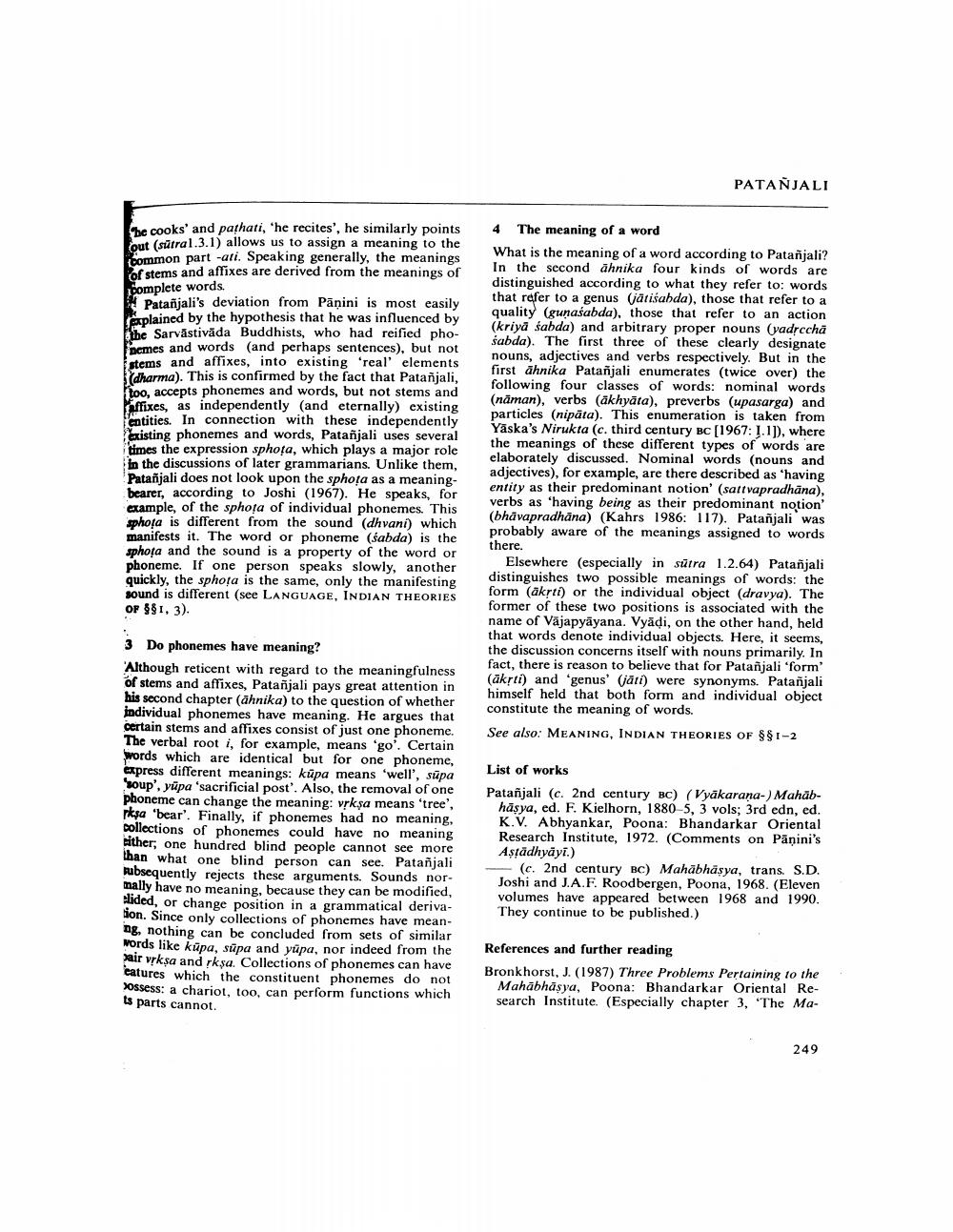Book Title: Patanjali Author(s): Johannes Bronkhorst Publisher: Johannes Bronkhorst View full book textPage 2
________________ PATANJALI The cooks and pathati, 'he recites', he similarly points out (sūtral.3.1) allows us to assign a meaning to the common part -ati. Speaking generally, the meanings Pof stems and affixes are derived from the meanings of zoomplete words. * Patañjali's deviation from Pāņini is most easily Paplained by the hypothesis that he was influenced by Elbe Sarvāstivāda Buddhists, who had reified phoPoemes and words (and perhaps sentences), but not stems and affixes, into existing 'real' elements dharma). This is confirmed by the fact that Patanjali, too, accepts phonemes and words, but not stems and Muffixes, as independently (and eternally) existing entities. In connection with these independently Existing phonemes and words, Patañjali uses several times the expression sphota, which plays a major role in the discussions of later grammarians. Unlike them, Patañjali does not look upon the sphofa as a meaningbearer, according to Joshi (1967). He speaks, for example, of the sphora of individual phonemes. This sphopa is different from the sound (dhvani) which manifests it. The word or phoneme (sabda) is the sphora and the sound is a property of the word or phoneme. If one person speaks slowly, another quickly, the sphosa is the same, only the manifesting sound is different (see LANGUAGE, INDIAN THEORIES OF 881, 3). 4 The meaning of a word What is the meaning of a word according to Patañjali? In the second ähnika four kinds of words are distinguished according to what they refer to: words that refer to a genus (jätisabda), those that refer to a quality (gunaśabda), those that refer to an action (kriya sabda) and arbitrary proper nouns (yadrcchā sabda). The first three of these clearly designate nouns, adjectives and verbs respectively. But in the first ähnika Patañjali enumerates (twice over) the following four classes of words: nominal words (näman), verbs (akhyāta), preverbs (upasarga) and particles (nipāta). This enumeration is taken from Yāska's Nirukta (c. third century BC (1967: 1.1]), where the meanings of these different types of words are elaborately discussed. Nominal words (nouns and adjectives), for example, are there described as 'having entity as their predominant notion' (sattvapradhāna), verbs as 'having being as their predominant notion' (bhāvapradhāna) (Kahrs 1986: 117). Patañjali was probably aware of the meanings assigned to words there. Elsewhere (especially in sūtra 1.2.64) Patañjali distinguishes two possible meanings of words: the form (akrti) or the individual object (dravya). The former of these two positions is associated with the name of Vajapyāyana. Vyādi, on the other hand, held that words denote individual objects. Here, it seems, the discussion concerns itself with nouns primarily. In fact, there is reason to believe that for Patanjali 'form (akrti) and 'genus (jani) were synonyms. Patanjali himself held that both form and individual object constitute the meaning of words. See also: MEANING, INDIAN THEORIES OF $81-2 3 Do phonemes have meaning? Although reticent with regard to the meaningfulness of stems and affixes, Patanjali pays great attention in his second chapter (ähnika) to the question of whether Individual phonemes have meaning. He argues that certain stems and affixes consist of just one phoneme. The verbal root i, for example, means 'go'. Certain words which are identical but for one phoneme, express different meanings: kupa means 'well', sūpa soup', yüpa 'sacrificial post'. Also, the removal of one phoneme can change the meaning: vrksa means 'tree, rksa 'bear'. Finally, if phonemes had no meaning, collections of phonemes could have no meaning bither, one hundred blind people cannot see more than what one blind person can see. Patanjali tubsequently rejects these arguments. Sounds normally have no meaning, because they can be modified, Alided, or change position in a grammatical derivadon. Since only collections of phonemes have meanng, nothing can be concluded from sets of similar Words like küpa, süpa and yupa, nor indeed from the air vrksa and rksa. Collections of phonemes can have catures which the constituent phonemes do not Sossess: a chariot, too, can perform functions which ts parts cannot. List of works Patañjali (c. 2nd century BC) (Vyakarana-) Mahāb hāşya, ed. F. Kielhorn, 1880-5, 3 vols; 3rd edn, ed. K.V. Abhyankar, Poona: Bhandarkar Oriental Research Institute, 1972. (Comments on Pāņini's Astādhyāyi.) -- (c. 2nd century BC) Mahābhäsya, trans. S.D. Joshi and J.A.F. Roodbergen, Poona, 1968. (Eleven volumes have appeared between 1968 and 1990. They continue to be published.) References and further reading Bronkhorst, J. (1987) Three Problems Pertaining to the Mahābhāşya, Poona: Bhandarkar Oriental Research Institute. (Especially chapter 3, "The Ma 249Page Navigation
1 2 3
